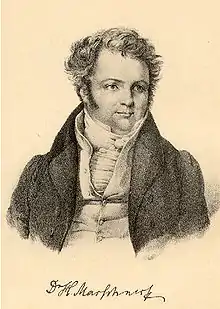Der Templer und die Jüdin
Der Templer und die Jüdin (English: The Templar and the Jewess) is an opera (designated as a Große romantische Oper) in three acts by Heinrich Marschner. The German libretto by Wilhelm August Wohlbrück was based on a number of intermediate works based in turn on Walter Scott's 1819 novel Ivanhoe.
| Der Templer und die Jüdin | |
|---|---|
| Opera by Heinrich Marschner | |
 Portrait of Heinrich Marschner in 1838 | |
| Translation | The Templar and the Jewess |
| Librettist | Wilhelm August Wohlbrück |
| Language | German |
| Based on | Walter Scott's Ivanhoe |
| Premiere | |
Performance history
The first performance took place at the Leipzig Opera on 22 December 1829. It became Marschner's most successful work and was staged more than 200 times in Germany during the next 70 years.
A revised version with recitatives rather than spoken dialogue was performed in Berlin on 3 August 1831 with Eduard Devrient as Bois-Guilbert. It was given in London at the Prince's Theatre on 17 June 1840, and in New York on 29 January 1872.
Many critics regarded the opera as unnecessarily complicated (and expensive to produce) and simplified versions were prepared by Felix Mottl, Richard Kleinmichel and finally Hans Pfitzner (1912). The latter's version was performed in Lübeck, Strasbourg and Cologne just before the First World War.
The opera was revived at the Wexford Festival in 1989, conducted by Albert Rosen and directed by Francesca Zambello, with William Stone as Bois-Guilbert and Greer Grimsley as the Black Knight.
Robert Schumann quotes an air from this opera in the finale of his Études symphoniques for piano.
Roles
| Role | Voice type | Premiere Cast, 22 December 1829 (Conductor: Heinrich Marschner) |
|---|---|---|
| Brian de Bois-Guilbert, Templar | baritone | Heinrich Hammermeister |
| Friar Tuck, Hermit of Copmanhurst | bass | Wilhelm Fischer |
| Cedric von Rotherwood, Saxon knight | bass | Wilhelm Pögner |
| The Black Knight (King Richard I) | bass | Eduard Schütz |
| Lokslei, the outlaw leader | baritone | |
| Lucas de Beaumanoir, Knights Templar Grand Master | bass | |
| Maurice de Bracy, Norman knight | tenor | |
| Rebecca, the Jewess, daughter of Isaac of York | soprano | Fortunata Franchetti-Wazel |
| Rowena von Hargottstandstede, ward of Cedric | soprano | Henriette Wüst |
| Wamba, a fool | tenor | August Wiedemann |
| Wilfried von Ivanhoe, son of Cedric | tenor | Ubrich |
| Oswald, Cedric's steward | bass | |
| Albert Malvoisin, Norman knight | spoken | |
| Conrad, Malvoisin's squire | spoken | |
| Elgitha, Rowena's maid | spoken | |
| Isaac of York, a Jew | spoken | |
| Walter, an outlaw | spoken | |
| Willibald, an outlaw | spoken | |
| Robert, Bois-Guilbert's squire | spoken | |
| Philip, Bois-Guilbert's squire | spoken | |
| Herdibert | spoken | |
Synopsis
The opera is set in England at the end of the 12th century and the main characters include The Black Knight, King Richard 'the Lionheart', Saxons, Normans, Templars and Robin Hood (here called Lokslei, i.e., Locksley) and his band of outlaws.
References
- Sources
- Casaglia, Gherardo (2005)."Der Templer und die Jüdin, 22 December 1829". L'Almanacco di Gherardo Casaglia (in Italian).
- Palmer, A Dean (1992), 'Templer und die Jüdin, Der' in The New Grove Dictionary of Opera, ed. Stanley Sadie (London) ISBN 0-333-73432-7